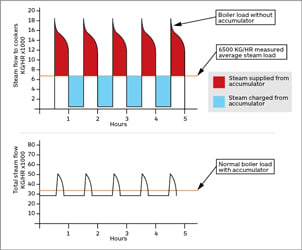Energy Storage for Paper and Board Mills
ENERGY STORAGE
Steam Accumulation
*David Oakland describes an energy efficient solution to steam generation problems in paper and board mills
Energy storage has become the ‘hot topic’ of the 21st century for energy managers and operators of power plant. For electricity generation the main impetus is the balancing of intermittent between supply and demand, and, in the wake of 2015 climate change summit in Paris, increasing compliance with governmental legislation for reducing environmental pollution. For industry it is increased operating efficiency, achieving a smaller carbon footprint, lower energy consumption and securing the needs of production. ‘Steam accumulation’ is a long established energy storage technology for achieving these aims and can potentially be the right solution for many of the operational problems tolerated in the power plant and production processes of paper and board mills.
So what are these problems:
The manufacture of paper and board involves processes that require large quantities of steam and power. In a paper mill, one of the largest consumers of steam is the paper machine which, whilst variable between paper type and production speed, is normally steady and predictable. However, the ‘status-quo’ can be interrupted as a result of a downturn or a total cessation of steam supply from the steam generators. This may be loss of steam from base-load thermo-mechanical pulping resulting in a rapid loss of pressure in the steam supply network causing in turn a rising or sudden demand on the supplementary fired boilers. This in turn increases the risk of ‘priming or even ‘lock-out’ being induced when approaching limits of high and low water level in the boiler steam drums. If a pressure-critical back pressure steam turbine is also being used to feed the paper machine, this may further increase the risk of ‘paper breaks’ resulting in loss of production. Moreover, higher demand on the fired boilers can increase energy cost if a premium fuel (gas or oil) is used.
Steam turbo-generator performance can suffer if the back-pressure or pass-out steam rate is governed by an irregular process steam demand which if below maximum turbine speed, power generation and efficiency is reduced. If the steam demand exceeds maximum turbine speed, the shortfall has to be supplemented by fired boilers to ‘reach the peak’.
Paper breaks at the paper machine can occur at random and result in a sudden cessation of demand on the steam supply system necessitating a rapid ramp-down of the steam generators.
Whilst this alone can be difficult alone to manage, the paper machine, upon start-up, can re-impose a sudden demand of considerably higher magnitude than that of a normal running load and which is potentially incapable of being met by the steam generators due to insufficiently fast reaction, thus again risking deleterious steaming conditions in the steam drums.
Pulp digesters also consume large quantities of steam and this batch process additionally imposes a highly fluctuating and randomly varying demand on the steam generators requiring steaming capacity sufficient to reach the ‘peak’ whilst also subject to rapidly changing firing rates.
A steam accumulator can balance all these conditions, maintain steam supply, reduce supplementary firing, hold steam generation performance, maximise turbogenerator output and improve overall plant operating efficiency.
What is steam accumulation:
Put simply, it is the storage of steam heat (in a pressure vessel – a steam accumulator) produced in the boiler at times of low demand for subsequent release to supplement the output of the boilers at times of high demand.
The term ‘steam accumulator’ is a misnomer and a more apt description would be ‘heat accumulator’. This is because water (not steam vapour) is used as the storage medium in the storage vessel. The reason becomes evident when the greater heat storage capacity of water is compared with that of the same mass of steam vapour by volume at any given state of temperature and pressure. Most accumulators work on the ‘pressure drop’ or ‘sliding pressure’ principle whereby steam from the generator is charged at high pressure into the water – thus raising its temperature and pressure. Discharge takes place when the steam contained in the steam space of the vessel is released, the consequent reduction in pressure causing an imbalance of temperature conditions with that of the water resulting in ebullition at the water surface and the evaporation of more steam (flash vaporisation) as discharge continues and vessel pressure falls.
How can a steam accumulator help:
A steam accumulator can provide a reserve of steam, instantly available, to maintain paper production in the event of a loss of boiler steam, can absorb excess steam during boiler ramp-down, can eliminate wide fluctuations of demand on the steam generators, improve the boiler load factor, reduce reliance on premium fuels, increase combustion efficiency and reduce fuel cost. If the power plant includes a steam turbo-generator, a steam accumulator would convert the variable process steam demand to a constant load thus enabling the electrical generator to be matched to the power demand and to run continuously for longer periods at higher output and at highest efficiency. And because of the ability of the accumulator to discharge steam instantaneously from ‘storage’ to meet sudden changes in demand, pressure in the steam distribution system is held constant and under a turbine plant trip, the standby boilers are given time to run up to full output and the interruptions that would otherwise occur need not be tolerated
What are the practical and economic benefits:
The benefits arising from balancing fluctuations of demand are based on improvements in steam generation performance and the potential for fuel savings. Operational savings can be evaluated financially with greater or less accuracy and relate to fixed capital, fuel and labour costs, and also to sundry costs associated with steam generation. However, other advantages are more difficult to assess. The reliability and simplification of the steam supply, the maintenance of steam conditions and the existence of a steam reserve are operational advantages that not only improve working conditions but secure the needs of production and improve product quality.
The most important energy savings obtainable from by steam accumulation derive from reducing and stabilising the necessary boiler output. Therefore the possibility of a steam accumulator meeting the steam demand with a smaller boiler plant is an important factor in investment decisions. Moreover, the improved thermal efficiency of steam generation achieved by balancing the load variations is also of considerable importance. The fuel losses due to irregular operation of the boilers vary greatly with the flexibility of the combustion equipment but doubtless, boiler efficiency is maximised when the boiler can be held at constant load within its rated output. The losses are due to part loading giving a low load factor, rapidly alternating loads and idle live capacity that increases standing heat and power losses.
Balancing of the boiler load also removes the adverse effects of load fluctuation on steam conditions, i.e., boiler pressure, steam temperature and steam dryness. Without steam storage, all load variations lead to some pressure change, whereas with an accumulator installed the pressure can be held constant. Also, the elimination of loss due to letting-off steam through safety valves has positive advantages for power generation and manufacturing processes. Moreover, the steam reserve in the accumulator is instantly available to secure the needs of production.
Account should also be taken of the greater strain on the boiler shell and pressure parts that is imposed by modern combustion equipment. Wide turndown response to the most demanding fluctuations leads to rapidly changing temperatures in the furnace and high thermal stressing of the metal. The longevity of boiler components and the minimisation of boiler maintenance costs are clearly allied to the stable load conditions that are enabled by the addition of steam accumulation.
Steam accumulation – its place in the modern boilerhouse:
Steam accumulation can be harnessed by designers of steam plant to secure higher energy efficiency, the creation of a steady boiler load and the provision of an immediate and unlimited supply of process steam while crucially assisting in the control of gaseous emissions and reducing energy consumption. The technology of steam accumulation should be viewed as a very useful and essential part of the modern boilerhouse and power plant.
*David Oakland is Principal Consultant at David Oakland Associates, a specialist UK ‘steam accumulation’ design provider
Download The PDF Here: DO562-1 Rev 1


